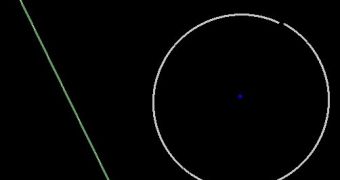In February 2040, a near-Earth object may pose a danger to our planet. The space rock carries the designation 2011 AG5, and is believed to be about 140 meters (450 feet) wide. While it's not on a direct collision course with Earth, experts are beginning to ponder methods of altering its course.
As the image to the left will confirm, the asteroid will pass relatively close to our planet, if current calculations of its trajectory are correct. In the diagram, the blue dot is our planet, the gray circle around it is the orbit of the Moon, and the green line is 2011 AG5's path.
Scientists will monitor this object closely, since any small alterations that may appear in its path around the Sun could either set it on a direct collision course, or cause it to hit us by a comfortable margin. Either way, it's best to know in advance, and prepare for the worse.
Though discovered only about a year ago (January 2011), the space rock has already become the near-Earth object (NEO) with the highest chances of impacting our planet in the immediate future. The NEO Office at the NASA Jet Propulsion Laboratory (JPL) has already complied a threat assessment sheet.
Details of the object, its path, and the likelihood of an impact were discussed by experts gathered at the 49th session of the Scientific and Technical Subcommittee of the United Nations Committee on the Peaceful Uses of Outer Space (COPUOS), which was held a few weeks ago in Vienna, Austria.
One of the things that make scientists uneasy about 2011 AG5 is that they have no idea of its mass and composition. “We have only observed it for about half an orbit, thus the confidence in these calculations is still not very high,” scientist Detlef Koschny explains.
The expert holds an appointment with the European Space Agency's (ESA) Solar Systems Missions Division (SSMD), in the Netherlands, Space reports.
“In our Action Team 14 discussions, we thus concluded that it not necessarily can be called a ‘real’ threat. To do that, ideally, we should have at least one, if not two, full orbits observed,” he adds.
“We are currently also in the process of making institutions like the European Southern Observatory aware of this object. We hope to make the point that this object deserves the allocation of some special telescope time,” Koschny concludes.
At this point, 2011 AG5 has a 1-in-625 chance of impacting Earth on February 5, 2040.

 14 DAY TRIAL //
14 DAY TRIAL //